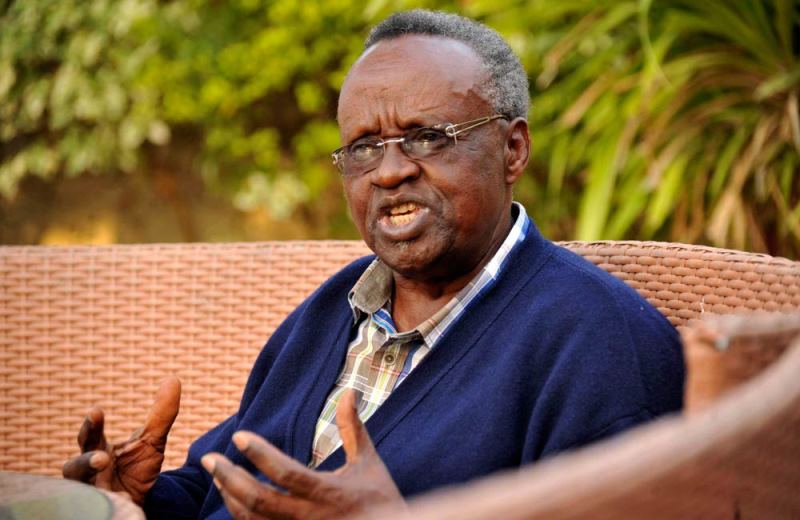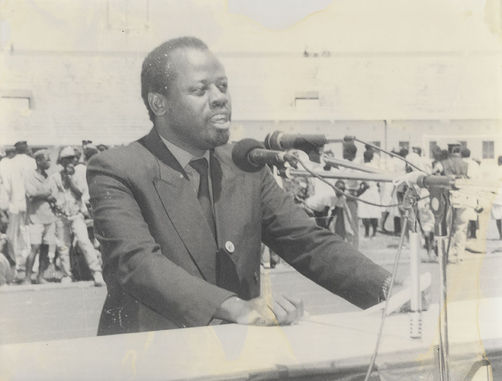
Dr. Odette Nyiramirimo during an interview with KT Press’ Tabaro Jean de la Croix
Hatred against Tutsi in Rwanda took shape towards the 1960s and intensified during the first and second republics.
However, some public events, speeches of influential politicians of the time constituted the 1994 Genocide against Tutsi kick-off.
Dr. Odette Nyiramirimo who was at the same time eye witness and target of criminals tells how a regime grew the hatred and sank the country into the Genocide.
Born in 1956, Nyiramirimo first witnessed persecution and hatred against Tutsis with an understanding of a young girl, but events escalated before her eyes through decades.
In 1988, Nyiramirimo who was an established medical doctor looking forward to a greater future of herself, her family and her country increasingly understood something wrong in the speeches of the then head of state President Juvénal Habyarimana.
The leader, she said, was pretending to promote unity, peace and equity, but in practice he was a different person.
“In that period of time, the Tutsi who had fled the country following the killings that intended to exterminate them were asking to return home peacefully, but Habyarimana would say: forget about that,” recalls Nyiramirimo.
In the contrary, whenever such a request was made, Habyarimana would look around and ill-treat the Tutsi in the country accusing them to be behind the repatriation campaign.
The situation of the Tutsi worsened since October 1, 1990 when Rwanda Patriotic Army(RPA) Inkotanyi declared a war against Rwanda entering from Uganda. The whole country was on alert.
“That day, my husband and I had attended a funeral service in the then Gitarama. We returned to Kigali in evening to find roadblocks mounted at every road junction. Soldiers ordered us to get off and checked us fiercely without explaining what was trending,” Nyiramirirmo narrates.
They were delayed at the roadblock and were only released at midnight and once at home, they found the same tension among children, who, during the day were being cursed with fellow students at Camp Kigali School-Nyarugenge district.
“Our children were confused. Their classmates had told them that one Kigeli had attacked Rwanda and that he was their relative,” she said.
Without further due, the government started arresting some Tutsi in the country accusing them of being accomplices – ibyitso.
None would afford to advance a different opinion on this crisis until 1991 when President Habyarimana accepted to endorse multi-parties regime after an order from Francophonie organization.
Quickly new parties were born including the Republican Democratic Movement (MDR), the Liberal Party(PL), the The Social Democratic Party (PSD) and the Christian Democratic Party (PDC) which has currently changed to Centrist Democratic Party.
They joined the then ruling party, the National Revolutionary Movement for Development (MRND).

Dr. Odette Nyiramirimo
Opposition parties came together to be able to face the ruling party – MRND and they created the Force Democratique de Changement(FDC) a coalition of opposition which was the start of a period that gave Habyarimana sleepless nights.
However, the more they came together, the more MRND created extremist parties. The country then started moving on two wheels, two blocs with a dozen of parties wholesomely.
However, in 1992, the opposition was becoming stronger and they advanced an idea of an inclusive government where they would also have members, including the Prime Minister.
Habyarimana said NO and instead put in place a Prime Minister from his party, in the name of Sylvestre Nsanzimana, a former rector of National University of Rwanda.
The parties contested Habyarimana’s choice and went to strike. They multiplied strikes until they succeeded.
Nyiramirimo, member of Liberal Party since the beginning and currently Secretary General of the later remembers some demonstrations she attended.
“I was working at Kigali University Teaching Hospital-CHUK at the same time teaching at the school of nurses but I could secure sometime for demonstration because we were looking forward to change,” she said.
After hit pressure, Habyarimana accepted opposition’s candidate and replaced Nsanzimana with Dismas Nsengiyaremye a.k.a Nsengimasi in the jargon of his fellow politicians.
“He was moderate, straightforward from MDR. He served for nearly two years until his party assumed he had started being corrupt by the ruling party,” Nyiramirimo said.
Justin Mugenzi and the origins of PL Power, MDR Power, the devil in opposition bloc
In 1993, the coalition of the opposition had an incident that cost them their solidarity.
One Justin Mugenzi who was President of Liberal Party, was a trusted person, eloquent, always challenging the ruling party to work on their shortcomings.

Justin Mugenzi, former Minister of Commerce in the government that prepared and executed the Genocide
His party had brought him forward to serve as Minister of Commerce due to these public speaking skills and the courage to dare the ruling party.
“Habyarimana refused Mugenzi’s candidacy, which sent us back to streets,” Nyiramirimo said adding that they reminded the president that he did not have power to refuse a candidate a party had proposed.
In the middle of that crisis, Mugenzi, then a businessman flew to France and, according to Nyiramirimo, his party “did not know the motive of his trip, the truth is that he returned a different person.”
“When Mugenzi returned from France, Habyarimana accepted to swear him in as Minister of Commerce. He was sworn in around September 1993.”
In the following month, President Melchior Ndadaye of the neighboring Burundi was killed and two days later, Frodouard Karamira who was vice president of MDR and Justin Mugenzi President of PL broke their parties into two.
“When they took the floor, the audience expected them to denounce the assassination of the Burundian president, but they launched an awful campaign,” said Odette Nyiramirimo.
“In their speeches, Karamira and Mugenzi said: You see! A Hutu president was killed in Burundi. From now on, you should know that the enemy of the Hutu is the Tutsi whoever they are.”
To this, they added: “from now on, be also informed that Hutu is power, the Hutu is the most powerful ethnic group.”
This divided the PL and MDR into two blocs respectively with Mugenzi being followed by a handful of people into PL Power and MDR Power by Karamira.

Frodouard Karamira who supported that the Tutsi are the enemy of the Hutu
However, the legal parties were led by Landouard Ndasingwa for PL and Faustin Twagiramungu of MDR’s Amajyojyi.
Nyiramirimo learnt about this meeting and the scandal while she was in Burundi in service of the American embassy.
“Both Karamira and Mugenzi were businesspeople who had invested in hardware industry. The ruling party had lured them into their hatred policy with a promise to give them all the government tenders,” said Nyiramirimo.
“That event exacerbated the hatred against the Tutsi and was the key event that ushered the country into the 1994 Genocide against Tutsi.”
Meanwhile, earlier on August 4, 1993, the Arusha peace accords were signed between Rwanda Patriotic Front (RPF) Inkotanyi and the government of Rwanda.
These accords had convinced everyone that the tension was over, that things would change for the Tutsi to be safe for ever.
“I personally had taken my children to Burundi fearing a crisis, but after the signing of peace accord, we brought them back. However, the speeches of Karamira and Mugenzi took the country backward.”
The ‘Powers’ since October 1993 put confusion in the opposition parties. They would interrupt their elections and meetings. They caused all the disorder and hatred.
Habyarimana trashes Arusha Peace Accords
On January 5, 1994, the transitional government and parliament that would include all political parties including RPF Inkotanyi was scheduled to be formed.
“Everyone was expecting a big event that would turn around the life of the country at Rwanda Parliament. President Habyarimana who was expected to preside over the event and to receive the oath after swearing in as president came, took oath and called it a day to the surprise of everyone,” recalls Nyiramirimo.
This event raised tension at the beginning of the year. Roadblocks started across the city with opposition parties contesting this move.
It became worse when on January 16, 1994 Habyarimana convened the meeting again for the swearing event and Interahamwe, the youth wing of MRND only allowed in members of the ruling party and the event did not take place.
This was the making of Habyarimana which worsened the situation.
“We were working at our health clinic in town. In evening it was difficult for us to drive from city centre to our Nyamirambo home until we were compelled to rent an apartment in Gitarama-Kabgayi where we would spend the night. We would wake up early morning to bring children to school in Camp Kigali at 7AM,” she said.
Initially, the Tutsi in the country were worried, but after the signing of Arusha peace accord, they understood that every problem was settled, but the behavior of Habyarimana warned them that there was not much to expect.
The crisis continued in the start of the year until April 7 when the government started executing the Genocide which was meticulously planned and tried in Bugesera-Eastern Province, Bigogwe-Northern Province and Muhororo-Western Province.
More than one million Tutsi lost their lives in this Genocide between April 7 and July 3, 1994 when RPF Inkotanyi stopped it.


